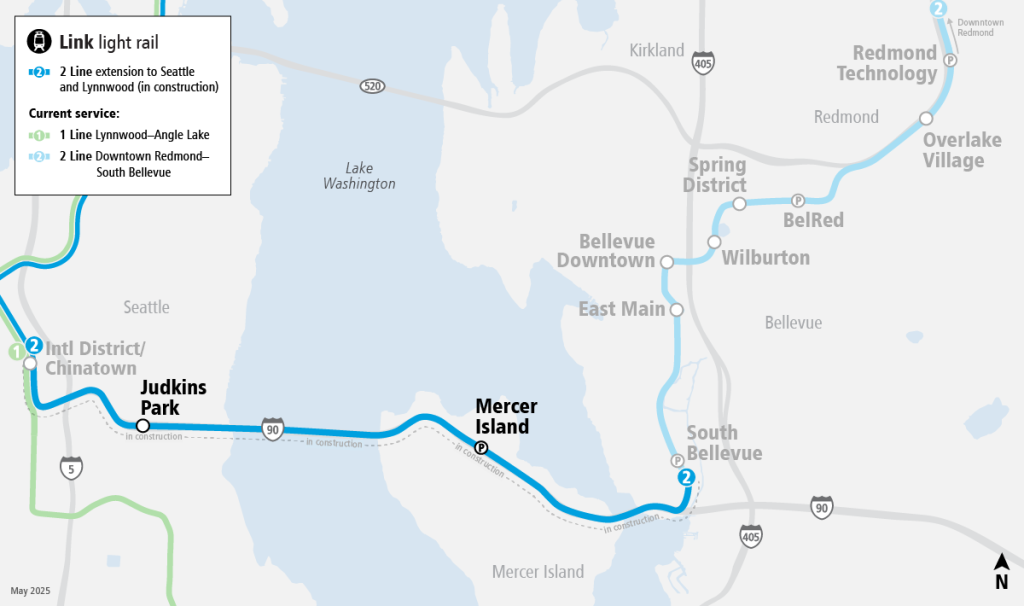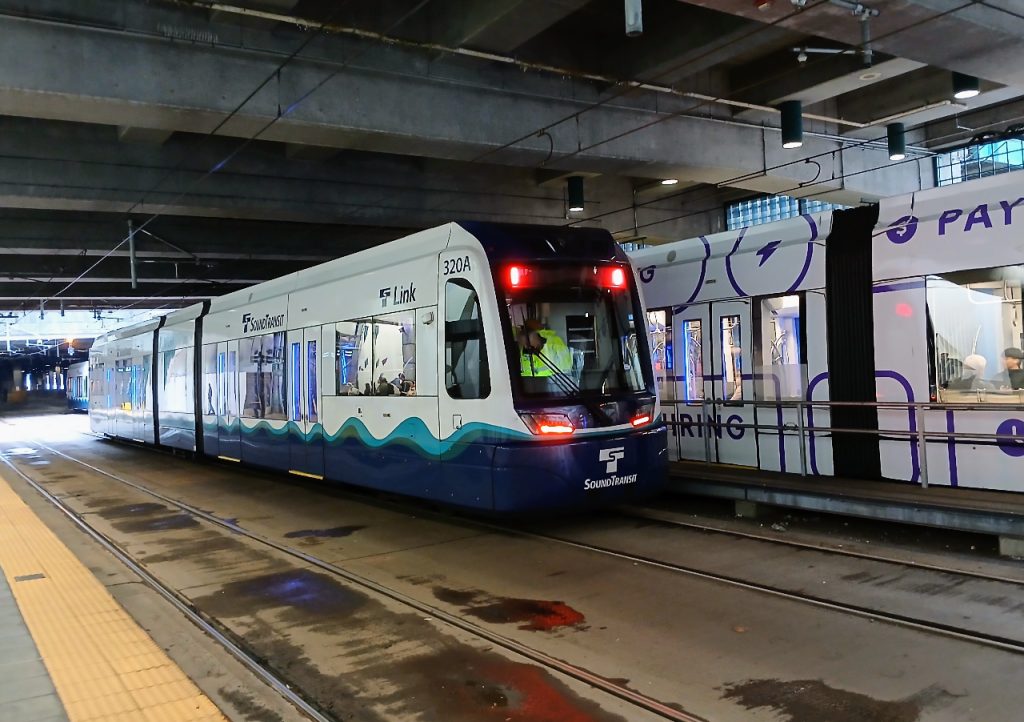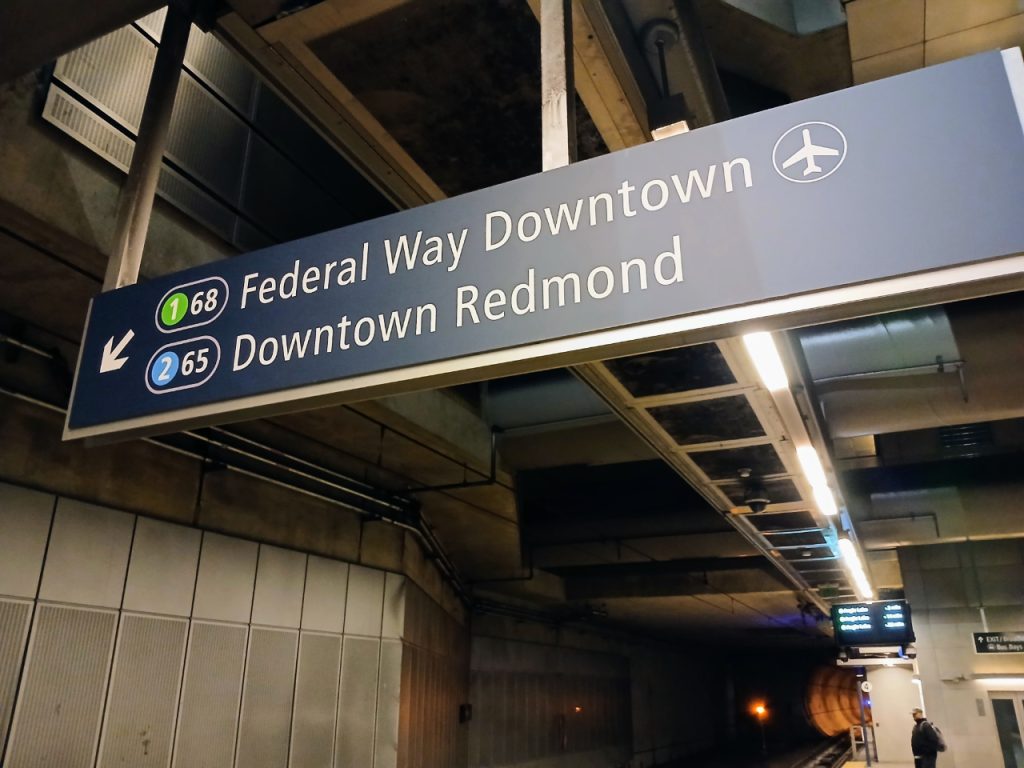
As Sound Transit continues to work toward a grand opening for the full 2 Line, finally connecting the growing light rail network across Lake Washington, signs of positive progress on testing are becoming more visible. With a ribbon-cutting still being eyed in March or April of next year, the new milestone serves as a mark of progress and will be sure to hype transit advocates up for one of the most highly anticipated transit expansions in Pacific Northwest history.
Starting next week, Sound Transit will begin operational trials on the segment of the 2 Line that shares tracks with the existing 1 Line, giving riders a preview of what train frequencies will look like when both lines start operating at the same time. The out-of-service trains won’t be opening their doors to riders quite yet, but will allow Sound Transit to get its feet wet managing train headways — the amount of time between train arrivals. Once the new line opens, train frequencies will double between International District-Chinatown and Lynnwood City Center stations.

Riders may already have noticed trains coming from the 2 Line and turning around at the pocket track at International District, as Sound Transit continues to test the segment of the 2 Line between Downtown Seattle and Judkins Park Station, at I-90 and Rainier Avenue. Running all the way to Lynnwood will be the next big move.
“Toward the end of this month, during select morning and evening peak hours, passengers can expect to see an out-of-service, single-car 2 Line train ‘interlining’ between regular 1 Line trains from International District/Chinatown Station to Lynnwood City Center Station,” the agency wrote in a blog post earlier this month. “These four-minute trials will happen intermittently over several weeks during peak periods as operators practice doubling our current service. Passenger service trains will continue to arrive every eight minutes during peak times.”

Earlier this week, those dates were officially confirmed, with a tentative schedule provided to The Urbanist showing testing mostly on Mondays and Tuesdays through mid-December. The times when riders will see the out-of-service trains are:
- Monday and Tuesday, Nov. 24-25: 4:30am – 9:30am
- Monday and Tuesday, Dec. 1-2: 2:30pm – 7:30pm
- Monday, Dec. 8: 4:30am – 9:30am
- Monday and Tuesday, Dec. 15-16: 2:30pm – 7:30pm
- Friday, Dec. 19: 4:30am – 9:30am
On top of that testing, Sound Transit expects to begin daytime testing across the I-90 bridge, after restrictions on when trains can run were loosened by the Washington State Department of Transportation (WSDOT), which owns and operates the bridge itself.
“We are expecting the first or second week of December, to start seeing trains on the bridge during the daytime,” Michael Morgan, executive director of the delivery team that includes East Link, told a Sound Transit board committee last week. “When there were early restrictions, we reorganized our testing program to focus at night, and so you still will see trains from 8pm until 7am, but the first trains on the bridge should be in the beginning of December, during the daytime.”
Also in December: weekend station closures that will require riders to board a bus bridge between Capitol Hill and SoDo Stations. Those closures, which come on the heels of planned maintenance closures this month, are needed to “add advanced signaling capabilities in the downtown tunnel,” according to Sound Transit.
One final thing riders have likely noticed: changing signage at stations, both to get ready for the launch of the 1 Line’s extension to Federal Way on December 6, but also for the full 2 Line connection across the lake. Despite the fact that trains won’t start carrying passengers to Downtown Redmond for several more months, Sound Transit says the new signage won’t be getting covered up.

“The new signs have been installed on a schedule that will ensure stations are updated with the correct information when 2 Line service begins next year,” Sound Transit spokesperson Henry Bendon told The Urbanist. “Signage upgrades require permitting and supervision like all other work completed in the right of way, which means we need an appropriate amount of lead time to ensure that everything is completely safely and properly. Additionally, onboard and in-station digital signage is accurate and will not change over until closer to 2 Line opening when testing is necessary. Trip planners, like google maps and transit app, also show the current information.”
With these (sometimes literal) signs of the forthcoming new connections all around the system, anticipation is only going to grow.
Ryan Packer has been writing for The Urbanist since 2015, and currently reports full-time as Contributing Editor. Their beats are transportation, land use, public space, traffic safety, and obscure community meetings. Packer has also reported for other regional outlets including BikePortland, Seattle Met, and PubliCola. They live in the Capitol Hill neighborhood of Seattle.


